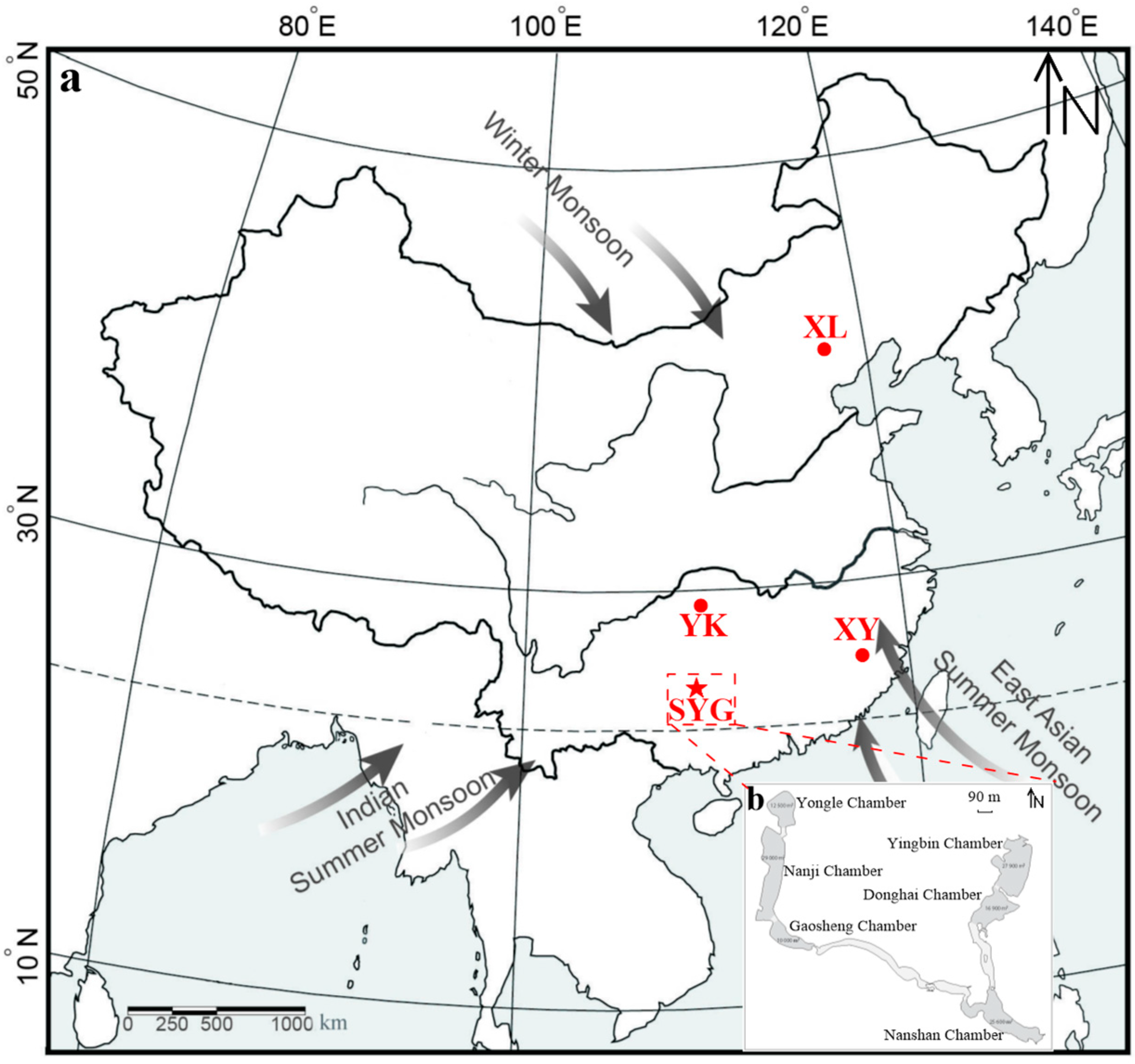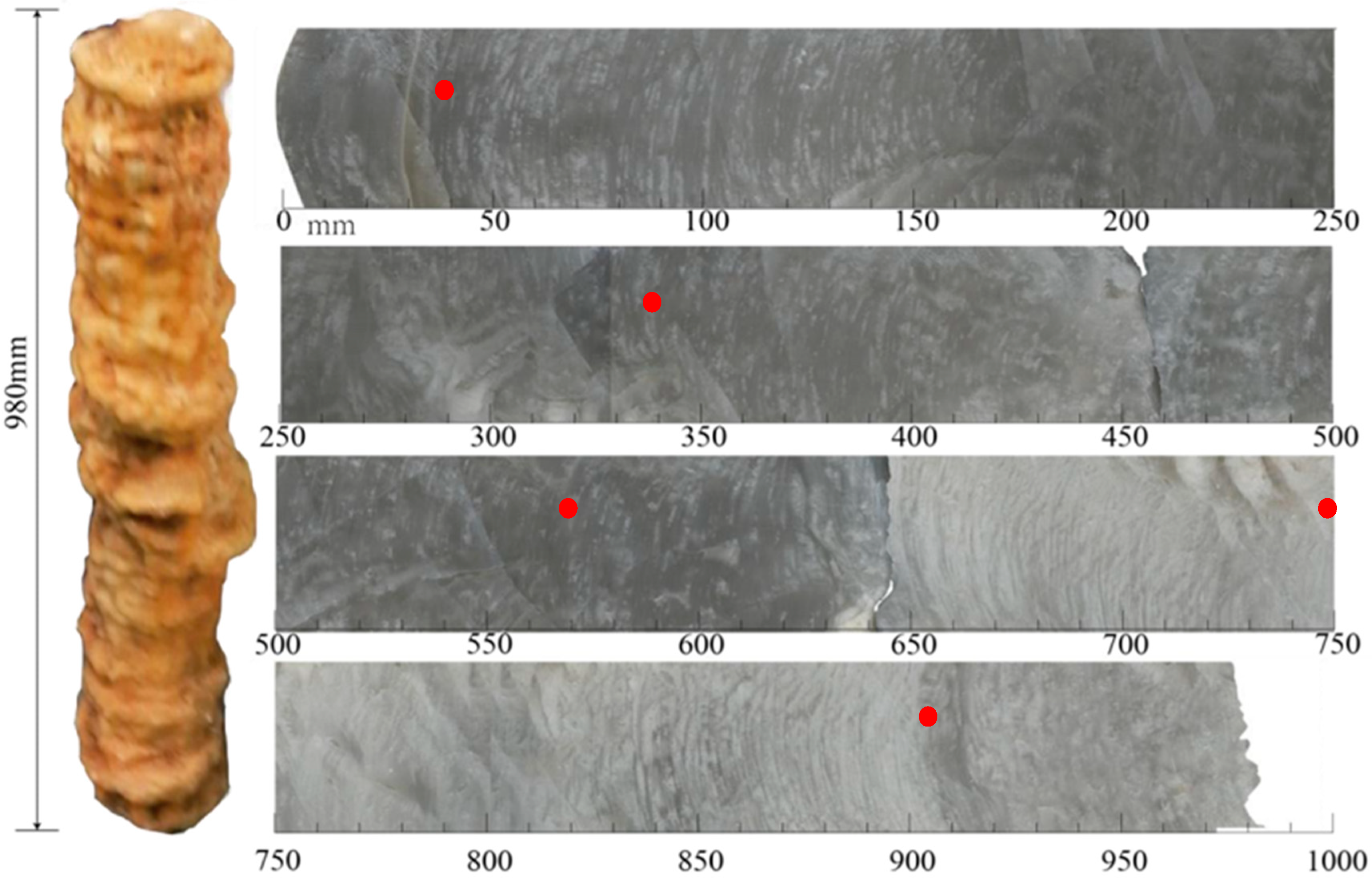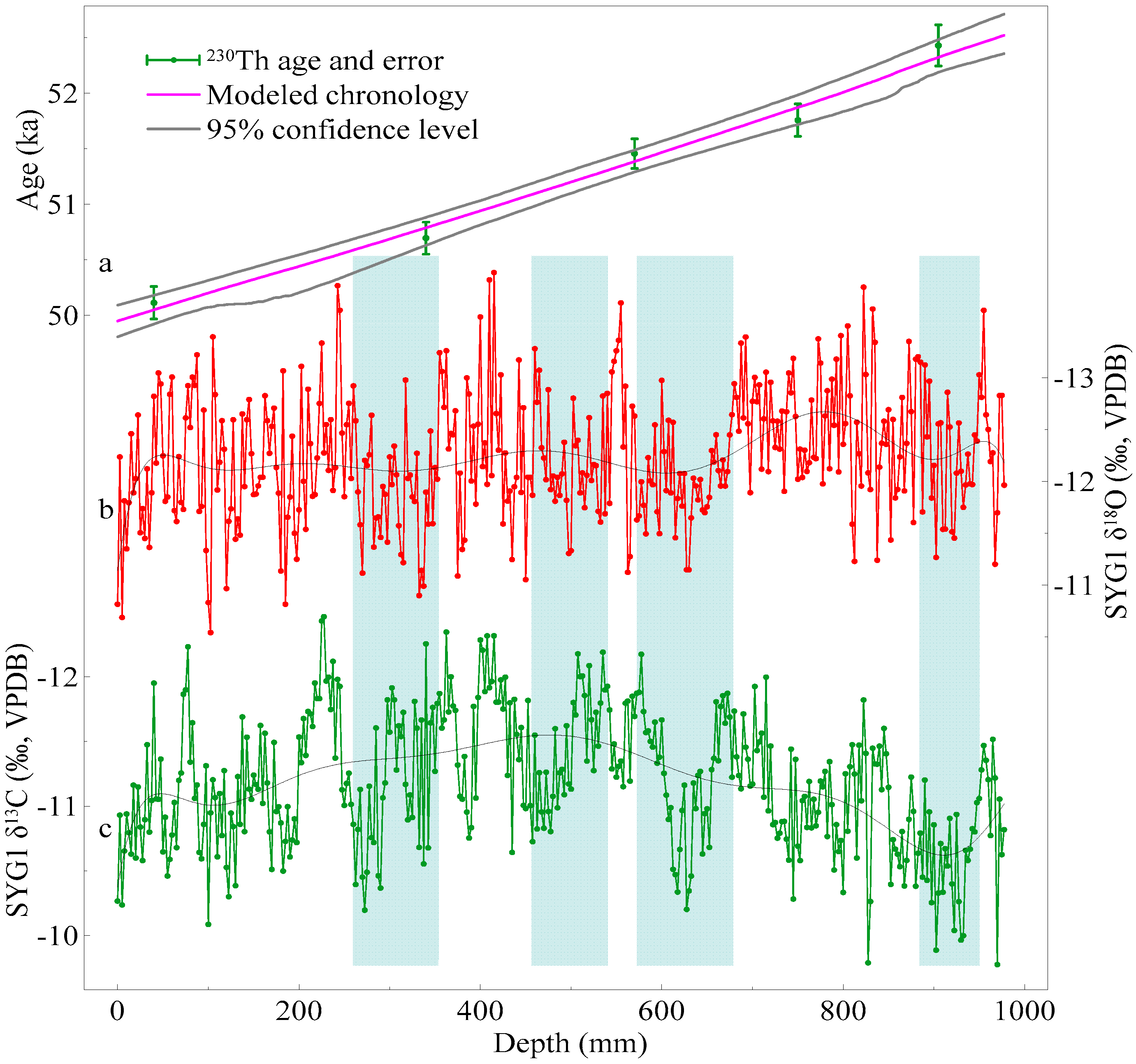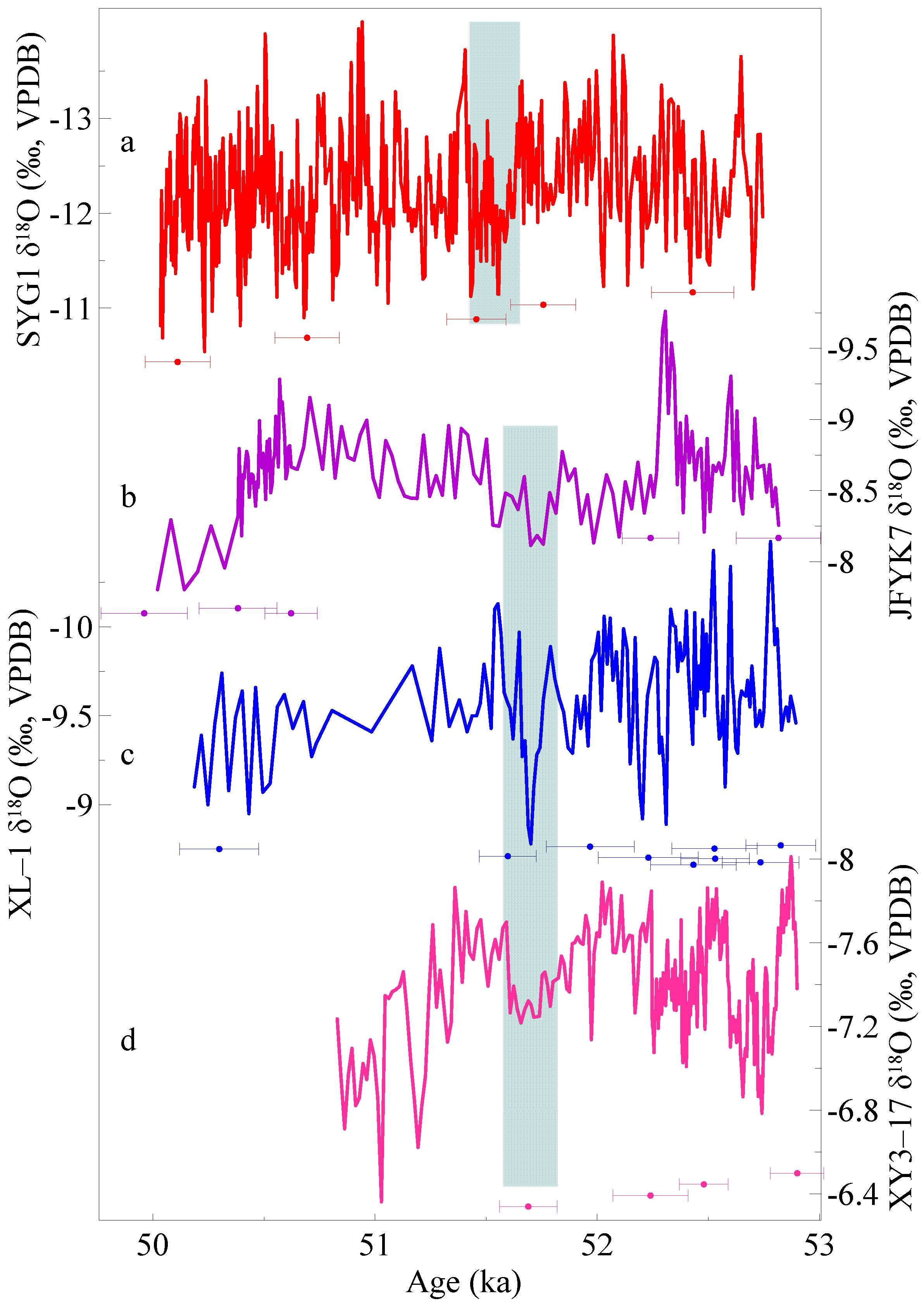Centennial-Scale Climatic Oscillations during the Dansgaard–Oeschger 14 Revealed by Stalagmite Isotopic Records from Shouyuangong Cave, Southern China
Abstract
:1. Introduction
2. Cave Site, Sample, and Methods
3. Results
3.1. Chronology
3.2. Oxygen and Carbon Isotope Records
4. Discussion
4.1. Centennial-Scale Coupling of ASM and Soil Processes
4.2. Forcing Mechanisms of Centennial-Scale Oscillations
5. Conclusions
Author Contributions
Funding
Data Availability Statement
Acknowledgments
Conflicts of Interest
References
- Hinnov, L.A.; Schulz, M.; Yiou, P. Interhemispheric Space–Time Attributes of the Dansgaard–Oeschger Oscillations between 100 and 0 Ka. Quat. Sci. Rev. 2002, 21, 1213–1228. [Google Scholar] [CrossRef]
- Voelker, A.H.L. Global Distribution of Centennial-Scale Records for Marine Isotope Stage (MIS) 3: A Database. Quat. Sci. Rev. 2002, 21, 1185–1212. [Google Scholar] [CrossRef]
- Jiang, X.; He, Y.; Wang, X.; Dong, J.; Li, Z.; Lonee, M.A.; Shen, C.-C. Journal of Asian Earth Sciences Sub-Decadally-Resolved Asian Monsoon Dynamics during Chinese Interstadial 21 in Response to Northern High-Latitude Climate. J. Asian Earth Sci. 2019, 172, 243–248. [Google Scholar] [CrossRef]
- Liu, S.; Liu, D.; Wang, Y.; Shao, Q.; Liang, Y.; Gao, H.; Mi, X. Insolation Control of Millennial-Scale Asian Summer Monsoon Changes Evidenced by Chinese Stalagmites δ18O Records. Quat. Int. 2022, 616, 30–39. [Google Scholar] [CrossRef]
- Dykoski, C.A.; Edwards, R.L.; Cheng, H.; Yuan, D.; Cai, Y.; Zhang, M.; Lin, Y.; Qing, J.; An, Z.; Revenaugh, J. A High-Resolution, Absolute-Dated Holocene and Deglacial Asian Monsoon Record from Dongge Cave, China. Earth Planet. Sci. Lett. 2005, 233, 71–86. [Google Scholar] [CrossRef]
- Soon, W.; Velasco Herrera, V.M.; Selvaraj, K.; Traversi, R.; Usoskin, I.; Chen, C.T.A.; Lou, J.Y.; Kao, S.J.; Carter, R.M.; Pipin, V.; et al. A Review of Holocene Solar-Linked Climatic Variation on Centennial to Millennial Timescales: Physical Processes, Interpretative Frameworks and a New Multiple Cross-Wavelet Transform Algorithm. Earth Sci. Rev. 2014, 134, 1–15. [Google Scholar] [CrossRef]
- Wang, Y.; Cheng, H.; Edwards, R.L.; He, Y.; Kong, X.; An, Z.; Wu, J.; Kelly, M.; Dykoski, C.A.; Li, X. Changes and North Atlantic Climate The Holocene Asian Monsoon: Links to Solar Changes and North Atlantic Climate. Science 2008, 303, 854–857. [Google Scholar] [CrossRef]
- Kravchinsky, V.A.; Zhang, R.; Borowiecki, R.; Tarasov, P.E.; Van Der Baan, M.; Anwar, T.; Goguitchaichvili, A.; Müller, S. Centennial Scale Climate Oscillations from Southern Siberia in the Last Glacial Maximum. Quat. Sci. Rev. 2021, 270, 107171. [Google Scholar] [CrossRef]
- Adolphi, F.; Muscheler, R.; Svensson, A.; Aldahan, A.; Possnert, G.; Beer, J.; Sjolte, J.; Björck, S.; Matthes, K.; Thiéblemont, R. Persistent Link between Solar Activity and Greenland Climate during the Last Glacial Maximum. Nat. Geosci. 2014, 7, 662–666. [Google Scholar] [CrossRef]
- Van Loon, H.; Brown, J.; Milliff, R.F. Trends in Sunspots and North Atlantic Sea Level Pressure. J. Geophys. Res. 2012, 117, D07106. [Google Scholar] [CrossRef]
- Soon, W.W. Solar Arctic-Mediated Climate Variation on Multidecadal to Centennial Timescales: Empirical Evidence, Mechanistic Explanation, and Testable Consequences. Phys. Geogr. 2009, 30, 144–184. [Google Scholar] [CrossRef]
- Soon, W.; Dutta, K.; Legates, D.R.; Velasco, V.; Zhang, W. Journal of Atmospheric and Solar-Terrestrial Physics Variation in Surface Air Temperature of China during the 20th Century. J. Atmos. Sol.-Terr. Phys. 2011, 73, 2331–2344. [Google Scholar] [CrossRef]
- Soon, W.; Legates, D.R. Journal of Atmospheric and Solar-Terrestrial Physics Solar Irradiance Modulation of Equator-to-Pole (Arctic) Temperature Gradients: Empirical Evidence for Climate Variation on Multi-Decadal Timescales. J. Atmos. Sol.-Terr. Phys. 2013, 93, 45–56. [Google Scholar] [CrossRef]
- Weng, H. Impacts of Multi-Scale Solar Activity on Climate. Part II: Dominant Timescales in Decadal-Centennial Climate Variability. Adv. Atmos. Sci. 2012, 29, 887–908. [Google Scholar] [CrossRef]
- Weng, H. Impacts of Multi-Scale Solar Activity on Climate. Part I: Atmospheric Circulation Patterns and Climate Extremes. Adv. Atmos. Sci. 2012, 29, 867–886. [Google Scholar] [CrossRef]
- Marchitto, T.M.; Muscheler, R.; Ortiz, J.D.; Carriquiry, J.D.; Van Geen, A.; Carriquíry, J.D.; Geen, A. Van Holocene Linked References Are Available on JSTOR for This Article: Dynamical Response of the Tropical Pacific Ocean to Solar Forcing During the Early Holocene. Geophys. Res. Lett. 2016, 330, 1378–1381. [Google Scholar]
- Bond, G.; Kromer, B.; Beer, J.; Muscheler, R.; Evans, M.N.; Showers, W.; Hoffmann, S.; Lotti-Bond, R.; Hajdas, I.; Bonani, G. Persistent Solar Influence on North Atlantic Climate during the Holocene. Science 2001, 294, 2130–2136. [Google Scholar] [CrossRef] [Green Version]
- Fleitmann, D.; Burns, S.J.; Mudelsee, M.; Neff, U.; Mangini, A.; Matter, A.; Fleitmann, D.; Burns, S.J.; Mudelsee, M.; Neff, U.; et al. Holocene Forcing of the Indian Monsoon Recorded in a Stalagmite from Southern Oman. Science 2016, 300, 1737–1739. Available online: http://www.jstor.org/stable/3834589 (accessed on 18 September 2016). [CrossRef] [Green Version]
- Gupta, A.K.; Das, M.; Anderson, D.M. Solar Influence on the Indian Summer Monsoon during the Holocene. Geophys. Res. Lett. 2005, 32, 2–5. [Google Scholar] [CrossRef] [Green Version]
- Hu, F.S.; Kaufman, D.; Yoneji, S.; Nelson, D.; Shemesh, A.; Huang, Y.; Tian, J.; Bond, G.; Clegg, B.; Brown, T. Cyclic Variation and Solar Forcing of Holocene Climate in the Alaskan Subarctic. Science 2016, 301, 1890–1893. Available online: http://www.jstor.org/stable/3835182 (accessed on 20 September 2016). [CrossRef] [Green Version]
- Neff, U.; Burus, S.; Mangini, A.; Mudelsee, M.; Fleitmann, D.; Matter, A. Strong Coherence between Solar Variability and the Monsoon in Oman between 9 and 6 Kyr Ago. Nature 2001, 411, 290–293. [Google Scholar] [CrossRef] [PubMed]
- Schmidt, M.W.; Weinlein, W.A.; Marcantonio, F.; Lynch-stieglitz, J. Solar Forcing of Florida Straits Surface Salinity during the Early Holocene. Paleoceanography 2012, 27, PA3204. [Google Scholar] [CrossRef] [Green Version]
- Duan, W.; Cheng, H.; Tan, M.; Edwards, R.L. Onset and Duration of Transitions into Greenland Interstadials 15.2 and 14 in Northern China Constrained by an Annually Laminated Stalagmite. Sci. Rep. 2016, 6, 20844. [Google Scholar] [CrossRef] [Green Version]
- Li, T.Y.; Han, L.; Cheng, H.; Edwards, R.L.; Shen, C.C.; Li, H.; Li, J.; Huang, C.; Zhang, T.; Zhao, X. Evolution of the Asian Summer Monsoon during Dansgaard/Oeschger Events 13–17 Recorded in a Stalagmite Constrained by High-Precision Chronology from Southwest China. Quat. Res. 2017, 88, 121–128. [Google Scholar] [CrossRef]
- Zhang, X.; Jiang, X.; Xiao, H.; Cai, B.; Yu, T.L.; Shen, C.C. A Gradual Transition into Greenland Interstadial 14 in Southeastern China Based on a Sub-Decadally-Resolved Stalagmite Record. Quat. Sci. Rev. 2021, 253, 106769. [Google Scholar] [CrossRef]
- Shao, Q.; Pons-branchu, E.; Zhu, Q.; Wang, W.; Fontugne, M. High Precision U/Th Dating of the Rock Paintings at Mt. Huashan. Quat. Res. 2017, 88, 1–13. [Google Scholar] [CrossRef] [Green Version]
- Shao, Q.F.; Li, C.H.; Huang, M.J.; Liao, Z.B.; Arps, J.; Huang, C.Y.; Chou, Y.C.; Kong, X.G. Interactive Programs of MC-ICPMS Data Processing for 230Th/U Geochronology. Quat. Geochronol. 2019, 51, 43–52. [Google Scholar] [CrossRef]
- Scholz, D.; Hoffmann, D.L. StalAge–An Algorithm Designed for Construction of Speleothem Age Models. Quat. Geochronol. 2011, 6, 369–382. [Google Scholar] [CrossRef]
- Jaffey, A.H.; Flynn, K.F.; Glendenin, L.E.; Bentley, W.C.; Essling, A.M. Precision Measurement of Half-Lives and Specific Activities of U235 and U238. Phys. Rev. C 1971, 4, 1889–1906. [Google Scholar] [CrossRef]
- Cheng, H.; Lawrence Edwards, R.; Shen, C.C.; Polyak, V.J.; Asmerom, Y.; Woodhead, J.; Hellstrom, J.; Wang, Y.; Kong, X.; Spötl, C.; et al. Improvements in 230Th Dating, 230Th and 234U Half-Life Values, and U-Th Isotopic Measurements by Multi-Collector Inductively Coupled Plasma Mass Spectrometry. Earth Planet. Sci. Lett. 2013, 371–372, 82–91. [Google Scholar] [CrossRef]
- Cheng, H.; Sinha, A.; Wang, X.; Cruz, F.W.; Edwards, R.L. The Global Paleomonsoon as Seen through Speleothem Records from Asia and the Americas. Clim. Dyn. 2012, 39, 1045–1062. [Google Scholar] [CrossRef]
- Tan, M. Circulation Effect: Response of Precipitation δ18O to the ENSO Cycle in Monsoon Regions of China. Clim. Dyn. 2013, 42, 1067–1077. [Google Scholar] [CrossRef]
- Wang, Y.J.; Cheng, H.; Edwards, R.L.; An, Z.S.; Wu, J.Y.; Shen, C.-C.; Dorale, J.A. A High-Resolution Absolute-Dated Late Pleistocene Monsoon Record from Hulu Cave, China. Science 2012, 2345, 2345–2348. [Google Scholar] [CrossRef] [PubMed] [Green Version]
- Cheng, H.; Edwards, R.L.; Sinha, A.; Spötl, C.; Yi, L.; Chen, S.; Kelly, M.; Kathayat, G.; Wang, X.; Li, X.; et al. 640,000 Years and Ice Age Terminations. Nature 2016, 534, 640–646. [Google Scholar] [CrossRef]
- Schulz, M.; Mudelsee, M. REDFIT: Estimating Red-Noise Spectra Directly from Unevenly Spaced Paleoclimatic Time Series. Comput. Geosci. 2002, 28, 421–426. [Google Scholar] [CrossRef]
- Andrews, J.A.; Schlesinger, W.H. Soil CO2 Dynamics, Acidification, and Chemical Weathering in a Temperature Forest with Experimental CO2 Enrichment. Glob. Biogeochem. Cycles 2001, 15, 149–162. [Google Scholar] [CrossRef]
- Genty, D.; Baker, A.; Massault, M.; Proctor, C.; Gilmour, M.; Pons-Branchu, E.; Hamelin, B. Dead Carbon in Stalagmites: Carbonate Bedrock Paleodissolution vs. Ageing of Soil Organic Matter. Implications for 13C Variations in Speleothems. Geochim. Cosmochim. Acta 2001, 65, 3443–3457. [Google Scholar] [CrossRef]
- Cerling, T.E.; Solomon, D.K.; Quade, J.; Bowman, J.R. On the Isotopic Composition of Carbon in Soil Carbon Dioxide. Geochim. Cosmochim. Acta 1991, 55, 3403–3405. [Google Scholar] [CrossRef]
- Keeling, C.; Mook, W.; Tans, P. Recent Trends in the 13 C/12 C Ratio of Atmospheric Carbon Dioxide. Nature 1979, 277, 121–123. [Google Scholar] [CrossRef]
- Blyth, A.J.; Smith, C.I.; Drysdale, R.N. A New Perspective on the Δ13C Signal Preserved in Speleothems Using LC-IRMS Analysis of Bulk Organic Matter and Compound Specific Stable Isotope Analysis. Quat. Sci. Rev. 2013, 75, 143–149. [Google Scholar] [CrossRef] [Green Version]
- Liu, D.; Wang, Y.; Cheng, H.; Edwards, R.L.; Kong, X.; Li, T.Y. Strong Coupling of Centennial-Scale Changes of Asian Monsoon and Soil Processes Derived from Stalagmite δ18O and δ13C Records, Southern China. Quat. Res. 2016, 85, 333–346. [Google Scholar] [CrossRef]
- Damon, P.E.; Peristykh, A.N. Radiocarbon Calibration and Application to Geophysics, Solar Physics, and Astrophysics. Radiocarbon 2000, 42, 137–150. [Google Scholar] [CrossRef] [Green Version]
- Muscheler, R.; Beer, J. Solar Forced Dansgaard/Oeschger Events? Geophys. Res. Lett. 2006, 33, 12–15. [Google Scholar] [CrossRef] [Green Version]
- Conant, R.T.; Ryan, M.G.; Ågren, G.I.; Birge, H.E.; Davidson, E.A.; Eliasson, P.E.; Evans, S.E.; Frey, S.D.; Giardina, C.P.; Hopkins, F.M.; et al. Temperature and Soil Organic Matter Decomposition Rates–Synthesis of Current Knowledge and a Way Forward. Glob. Chang. Biol. 2011, 17, 3392–3404. [Google Scholar] [CrossRef]
- Kutzbach, J.E.; Liu, X.; Liu, Z.; Chen, G. Simulation of the Evolutionary Response of Global Summer Monsoons to Orbital Forcing over the Past 280,000 Years. Clim. Dyn. 2008, 30, 567–579. [Google Scholar] [CrossRef]
- Webster, P.J. The Role of Hydrological Processes in Ocean-AtmospherE Program in Atmospheric and Oceanic Sciences. Rev. Geophys. 1994, 32, 427–476. [Google Scholar] [CrossRef]






| Sample Number | Depth (mm) | 238U (ppb) | 232Th (ppt) | δ234U(‰) (Measured) | 230Th/238U (10−3) (Activity) | 230Th/232Th (Activity) | 230Th Age (ka) (Uncorrected) | 230Th Age (ka) (Corrected) | δ234UInitial (‰) (Corrected) |
|---|---|---|---|---|---|---|---|---|---|
| SYG1-40 | 40 | 119.37 ± 0.04 | 279.9 ± 10.0 | 25.9 ± 1.0 | 379.4 ± 0.7 | 494.5 ± 17.7 | 50.2 ± 0.1 | 50.1 ± 0.1 | 29.9 ± 1.6 |
| SYG1-340 | 340 | 123.15 ± 0.05 | 212.3 ± 10.0 | 28.0 ± 1.1 | 383.6 ± 0.7 | 680.2 ± 32.0 | 50.7 ± 0.1 | 50.7 ± 0.1 | 32.2 ± 1.2 |
| SYG1-570 | 570 | 132.03 ± 0.04 | 205.3 ± 10.1 | 28.8 ± 1.0 | 388.5 ± 0.7 | 763.5 ± 37.4 | 51.5 ± 0.1 | 51.5 ± 0.1 | 33.4 ± 1.1 |
| SYG1-750 | 750 | 125.17 ± 0.04 | 257.1 ± 10.1 | 27.9 ± 1.1 | 390.0 ± 0.7 | 580.2 ± 22.5 | 51.8 ± 0.1 | 51.8 ± 0.1 | 32.3 ± 1.2 |
| SYG1-905 | 905 | 91.48 ± 0.03 | 153.6 ± 10.2 | 29.3 ± 1.4 | 394.4 ± 0.9 | 717.7 ± 47.8 | 52.4 ± 0.2 | 52.4 ± 0.2 | 34.0 ± 1.7 |
Publisher’s Note: MDPI stays neutral with regard to jurisdictional claims in published maps and institutional affiliations. |
© 2022 by the authors. Licensee MDPI, Basel, Switzerland. This article is an open access article distributed under the terms and conditions of the Creative Commons Attribution (CC BY) license (https://creativecommons.org/licenses/by/4.0/).
Share and Cite
Liu, S.; Zhang, Z.; Zhai, X.; Chen, J.; Zhang, Y.; Long, P.; Chen, Z. Centennial-Scale Climatic Oscillations during the Dansgaard–Oeschger 14 Revealed by Stalagmite Isotopic Records from Shouyuangong Cave, Southern China. Geosciences 2022, 12, 400. https://doi.org/10.3390/geosciences12110400
Liu S, Zhang Z, Zhai X, Chen J, Zhang Y, Long P, Chen Z. Centennial-Scale Climatic Oscillations during the Dansgaard–Oeschger 14 Revealed by Stalagmite Isotopic Records from Shouyuangong Cave, Southern China. Geosciences. 2022; 12(11):400. https://doi.org/10.3390/geosciences12110400
Chicago/Turabian StyleLiu, Shushuang, Zhenqiu Zhang, Xiumin Zhai, Jianshun Chen, Yuanhai Zhang, Ping Long, and Zhiqiang Chen. 2022. "Centennial-Scale Climatic Oscillations during the Dansgaard–Oeschger 14 Revealed by Stalagmite Isotopic Records from Shouyuangong Cave, Southern China" Geosciences 12, no. 11: 400. https://doi.org/10.3390/geosciences12110400
APA StyleLiu, S., Zhang, Z., Zhai, X., Chen, J., Zhang, Y., Long, P., & Chen, Z. (2022). Centennial-Scale Climatic Oscillations during the Dansgaard–Oeschger 14 Revealed by Stalagmite Isotopic Records from Shouyuangong Cave, Southern China. Geosciences, 12(11), 400. https://doi.org/10.3390/geosciences12110400








